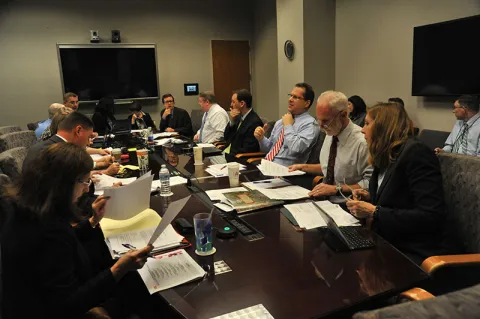The federal courts remained open during the October 2013 government shutdown by utilizing fee revenue, but it was far from business as usual.
Federal Courts Continue to Exercise Judicial Powers
As the end of fiscal year 2013 neared, Congress had not completed work on any of the 12 appropriations bills to fund federal government operations. Judge John D. Bates, on behalf of the Judicial Conference, wrote to President Obama seeking assistance in ensuring that the federal Judiciary received sufficient funding in fiscal year 2014 and warning that a hard freeze at post-sequestration levels would further diminish all aspects of court operations.
A Continuing Resolution extending funding through December 15, 2013, was considered but failed to pass the House. Although most federal entities immediately implemented shutdown plans, the Judiciary continued operations, utilizing fees and no-year appropriations. Initial projections allowed the Third Branch of government to run for 10 business days, from October 1 through October 15, 2013. Subsequently, by severely restricting spending, the courts were able to remain open and exercising their judicial duties through October 18.
Courts Experience Work Disruptions
While the courts remained open during the government-wide shutdown, they were far from immune to its impact. Criminal litigation continued, but U.S. Attorneys were directed to “curtail or postpone” civil litigation “to the extent this can be done without compromising . . . the safety of human life or the protection of property.” As a consequence, case by case, U.S. Attorneys filed motions for stays of litigation. U.S. Attorneys representing the IRS, who participate in numerous bankruptcy cases where tax payments are delinquent, were not available for cases and out-of-courtroom negotiations.
The courts responded in varying ways. Orders staying civil cases were issued in some district courts, particularly civil cases in which the U.S. Attorney’s Office appeared as counsel. In the bankruptcy courts, many cases were postponed, although the most time-sensitive matters went forward.
Impact throughout the court system included delays in bankruptcy and Social Security cases, condensed criminal calendars, cuts in building maintenance, and uncertainty over juror payments.

Courts from Guam to New York City participated in nationwide conference calls, during which judges and court staff queried AO staff experts and received guidance on court operations during a partial government shutdown.
Planning Begins for a Judiciary Shutdown
In the week leading up to October 18, many courts began to issue orders, identifying essential personnel in the event that Congress did not enact FY 2014 appropriations before the Judiciary’s fee balances were exhausted. The AO, after careful review, would have had to furlough a substantial number of AO staff.
The AO provided extensive guidance to courts and federal defender organizations about operations once fees were exhausted. In two nationwide conference calls, more than 850 judges and court staff queried AO staff experts and received guidance on court operations during a partial government shutdown. Courts from Guam to New York City participated in the 90-minute calls. Participants e-mailed questions to a specific mailbox created for the calls where AO staff responded.
Continuing Resolution Funds Judiciary for First Quarter FY 2014
On October 16, 2013, as the Judiciary prepared to implement its shutdown plans, Congress passed and the President then signed a Continuing Resolution (CR) funding government operations through January 15, 2014.
The CR provided a hard-freeze funding level for Judiciary accounts with the exception of two funding anomalies (increases) for the Defender Services and Salaries and Expenses (S&E) accounts.
These two anomalies were a remarkable achievement given that there were very few funding increases in the CR—most federal agencies were held to a hard freeze. Funding halted additional furloughs in Federal Defender Offices and paid for deferred 2013 Criminal Justice Act (CJA) vouchers, while S&E money partially restored funding for probation and pretrial drug and mental health treatment and testing services during the CR period, as well as reduced the across-the-board cut to court operations. Some of the CR funding was used for court security to reduce the total 50-hour cut per court security officer from November 15, 2013 through January 15, 2014, and also to cover a potential shortfall in the Juror’s account during the CR period.
Funding Approved for Fiscal Year 2014
On January 17, 2014, the President signed into law the Consolidated Appropriations Act, funding the federal government for the fiscal year ending September 30, 2014. The Act appropriated $6.5 billion in discretionary funds for the Judiciary, which is 5.1 percent above the $6.2 billion appropriated to the Judiciary in FY 2013 (post sequestration), essentially equal to the level requested in the Judiciary’s December 5, 2013, appeal letter (pdf) to Congress.
Annual Report 2013
- Annual Report 2013
- Judiciary Funding
- Fiscal Year 2013: Budget Sequestration and the Judiciary
- Fiscal Year 2014: No Budget and a Government Shutdown
- Judiciary's Cost-Containment Efforts
- Sequestration's Impact on Judiciary's Programs and Operations
- The Courts and Congress
- Judges and Court Staff
- Accountability
- The Courts
- Court Management, Financial Systems, and Statistical Reporting
- Ongoing Pilots, Projects, and Reports
- Facilities and Security
- Public Accessibility and Service
- Defender Services
- Probation and Pretrial Services
- Federal Rules of Practice and Procedure
- In Profile: The Administrative Office of the U.S. Courts
